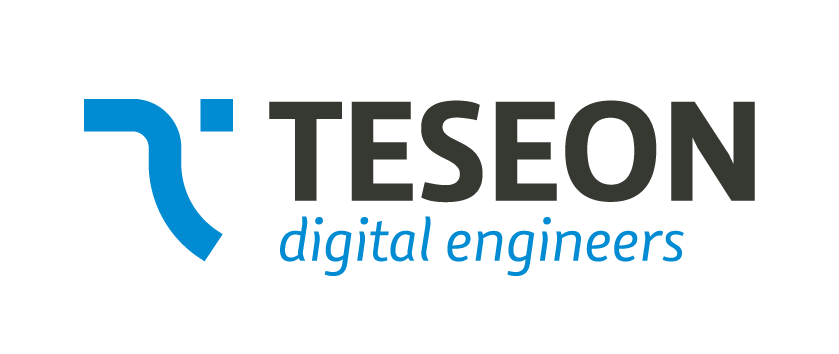
TESEON is your specialist for innovation and product development in digital transformation. Together with you we design your digitization strategy and develop successful business models for you. From the product and service idea to the handling of your complex development projects, you benefit from the many years of experience and outstanding methodological expertise of the industry-experienced TESEON engineers. Innovation is the key to your future success!
Digitization strategy
Master the digitization and actively shape the digital transformation of your company on the basis of a suitable digitization strategy.
Digital Transformation describes the process of change in an organization that enriches or completely transforms its business processes, products, and services with digital technologies in order to remain competitive or gain even greater market advantage.
The digitization strategy must provide answers to the following fields of action of the digital transformation:
- Strategy and Management
Orientation and leadership of the company in the digital future - Organization
Adaptation of the organizational structure to the digital requirements - Competencies and culture
Development of digital company competencies and a culture of change - Customer Experience
Design the customer experience across all contact points - Product Service Innovation
Development of products and services based on digital possibilities - Business models
Development of new business models that can only be implemented digitally - Collaboration
Establish new ways of internal and external cooperation - Business processes
Digitization and automation of processes - Infrastructure
Creation of the technical, digital infrastructure

Together with you, we develop your digitization strategy in a three-step process model:
- Positioning
First, in a location analysis, the determination of the digital degree of maturity. In addition, the target definition for the digital version is done. - Strategy development
In the second step, the strategy for digital transformation is determined. A digitization strategy is developed. This may include the development of digital business models. The need for transformation is determined: what new digital skills – technical, methodological and social – are required? As part of a roadmap, the need for transformation is planned. - Strategy implementation
In the third phase, the planning and realization of the digital transformation takes place. Required digital skills are built up. The development of innovative products and services is focused on generating maximum customer value. An agile approach is established
Business Model Innovation
Ensure the long-term success of your company by systematically developing innovative business models and aligning existing business models with increased customer benefits.

Today, innovation must not focus solely on product and process innovations. For sustainable economic success, it is crucial to constantly question and optimize the entire business model.
The business model describes the relationships between how a business generates benefits for its customers and value for itself. Digital technologies create new opportunities to create customer value. Thus, digitization in particular makes completely new business models possible and necessary.
The goal of business model innovation is to consciously and systematically find starting points for innovations that specifically change the existing business model (evolution) or generate a new model (revolution or disruption) that creates advantages over its competitors.
Business model innovation does not necessarily require the development of completely new ideas. Much of the business model innovation is new combinations of parts of “old” or “different” business models or evolutionary digitization of existing elements.
To successfully work together on the business model, we use techniques to visualize the business model. The Business Model Canvas makes the components of the business model visible, assessable and optimizable.
Product and service innovation
TESEON digital engineers Increase customer value and create competitive advantage by adding digital technologies to existing products and developing new product and service innovations based on digital capabilities.

The use of digital technologies is for us as a private customer, e.g. in online banking and shopping, has long become the standard. Even more hesitant in the industrial sector, digital solutions are increasingly gaining ground. The customer is a driver of digitization. He wants tailor-made, individual products and services that save time, offer meaningful functions or simply bring comfort.
"Innovation is for growth like oxygen is for humans. Without the power of new ideas, we cannot live and develop."
Compared to today’s core products, you can shape your future product and service innovations differently in terms of digitization level and level of innovation. The range extends from the use of digital possibilities in existing products to the development of new digital business models in which even the original product completely disappears:
- Access to the product by digital methods
- Digital communication of the product with its users
- Digital networking of the product with its environment
- “Data-based innovation”
- Development of completely new digital products and services
- Development of digital business models
With a product service innovation, you can offer your customers a whole new level of performance. The focus is on the question: How can we create real added value for the benefit of our customers? Does the customer really want to buy the product itself, or is the result that the product must achieve more important to him? In order to generate successful product service innovations, it is necessary to create a framework in which a completely new kind of thinking can and indeed must be conceived.
Digital Customer Experience
Recognize the potential of comprehensive customer loyalty and enthusiasm. Digitalisation opens up new possibilities for contact points with your customers.

Customer satisfaction is an indicator that describes the extent to which the customer’s expectations of the product are met. There are rational and objective influencing factors that contribute to customer satisfaction. Much more important, however, is the subjective and emotional evaluation of the service provided. “You do not have any influence on that,” you may think now. The concept of customer experience starts at this point, with the goal of building an emotional relationship with each customer at each touchpoint. Satisfied customers should become loyal customers. Loyal customers should eventually become enthusiastic customers.
Touchpoints are all contact points that customers have with a company. This goes from the first customer contact over the purchase of a service up to the customer service with questions or problems to the product. Every contact with the customer is crucial and should not happen by chance. For this reason, it is the first step towards a successful customer experience management to systematically capture and prioritize these contacts and evaluate the potential.
Digital engineering advances provide many additional opportunities to gather detailed information from customers that can be leveraged for successful customer experience management. Targeted digital contact points can also be designed through which an interaction with the customer can take place. Digitization is not just a matter of fundamental transformation for the production and collaboration, but also the way customer relationships will be shaped in the future. Together with you, we rethink and digitize the customer contact points in your company.
Digital engineering

Embrace the opportunity that digitization opens up for the product development process. Dominate product complexity, increase planning quality and improve process efficiency through consistent use of digital methods and tools in engineering.

